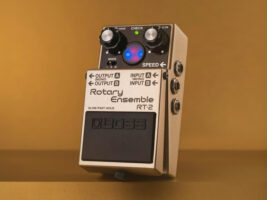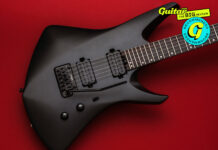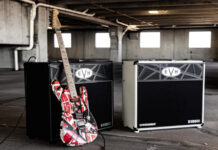
Boss RT-2 Rotary Ensemble review – a compact Leslie sim that doesn’t compromise on features
$239/£229, boss.info
Different modulation effects seem to come in and out of fashion – it’s flanging this week, hadn’t you heard? – but the rotary speaker sound is different. The ‘Leslie effect’ is older than rock music itself, and it’s just too beautiful to worry about its position in the guitar stompbox pantheon.
READ MORE: EarthQuaker Devices Easy Listening review – can an amp simulator this simple actually sound good?
Two things have changed in recent years, though: the power of digital processing has made it much easier to simulate the sound of a Leslie cabinet, and guitarists are demanding smaller pedals so they can fit more of them on their ‘boards. Toss all of that information into a cauldron, add the biggest brand name in pedaldom, and what comes out is the Boss RT-2 Rotary Ensemble.
Image: Adam Gasson
Boss RT-2 Rotary Ensemble – what is it?
If I say it’s a compact Leslie sim, you might be ready to move on to the next section already. But please don’t – it took me ages to write this bit. It’s a story that takes us all the way back to the 1930s: designed for organs rather than guitars, the original Leslie cab used spinning drivers (well, strictly speaking one spinning driver and one spinning baffle) to create an intense and distinctive kind of modulation based on the Doppler effect. It soon became a key component of the Hammond sound.
A number of guitarists started using Leslies in the 60s; but while compact phaser, flanger and chorus pedals were all over the stages of the 80s, it seems the rotary effect’s multi-dimensional wobble was just too complex to be miniaturised in the same way using analogue tech. The H&K Tube Rotosphere had a good go in the late 90s – and remains a hugely respected pedal to this day – but it was a whopper, as were early digital efforts like the Korg G4.
Then came Neo Instruments. This German company has been making Leslie sims since 2010, most notably the not-quite-compact Mini Vent (launched in 2013) and a pair of very-much-compact Micro Vent models (2019). All the Vents share one important design feature: they sound frickin’ fantastic. And that’s the bar that the RT-2 is aiming to clear.
This is not Boss’s first rotary pedal – there was a much bigger version, the RT-20, in the now-discontinued 20 series. But that unit had two footswitches, seven knobs and a four-way mode switch. How much of that has survived the transition to the classic single-stomp format? Well, as it turns out, pretty much all the important bits.
Ramping between fast and slow speeds is a major part of the Leslie recipe; in the absence of a second footswitch, it’s done here by holding the bypass switch down for a second. Those two speeds are set via concentric knobs on the right, while another pair on the left handle output level and overdrive. A couple of switches round the back let you choose your ramping time (fast or slow) and repurpose the drive knob to alter the balance between the two virtual drivers (a low-frequency drum and a high-frequency horn).
There’s just a three-way mode switch this time, and stereo ins and outs plus an expression pedal input for controlling the speed manually… oh, and a simplified version of the RT-20’s kerrr-azy light show for giving a visual representation of the two spinning speakers.
Image: Adam Gasson
Boss RT-2 Rotary Ensemble – is it easy to use?
As long as you’ve got at least one working ankle, getting started with the RT-2 is stupendously simple. Tap once to turn it on, tap once to turn it off, hold until the status LED changes colour to set it off a-ramping; as a system, it’s impossible to forget and (nearly) impossible to get wrong. The pedal even comes with a battery fitted, although – as ever with digital pedals – you’re better off with an external power supply.
The controls are self-explanatory, with no quirks or surprises. And while the red and blue lights don’t really do anything vitally important, they do provide a visual representation of the imaginary drivers’ rotation (blue for the drum, red for the horn) that’s weirdly compelling. You’d definitely miss them if they stopped working.
Image: Adam Gasson
Boss RT-2 Rotary Ensemble – what does it sound like?
If you stand in front of a speaker cabinet containing two drivers with their output spinning in opposite directions, you’re going to hear a lot of modulation – a combination of chorus, phasing and tremolo that’s somehow richer than any of them but in a way that isn’t overwhelming. That’s the unique sorcery of the Leslie sound, and the RT-2 does it… reasonably well.
There’s no mistaking that this is a rotary sim, and Boss has captured every element of the sound – including the way the two rotors accelerate and decelerate at different speeds in the transitions. It swirls around sinuously in slow mode, and wibbles delicately in fast mode. Run it through two amps and you get a decent stereo spread that adds a whole load of immersive realism. In short, it does the job.
What it doesn’t do is sound unconditionally gorgeous. It’s nice enough, but sometimes the voicing of the RT-2 seems a little overbearing in the midrange – maybe a blend control would have helped? – while the effect can get woozy at slower speeds, perhaps because of a tad too much emphasis on the tremolo element. Just to be clear, it’s good… but the competition is better.
The first two modes are strangely similar, but the third shakes things up tonally and also adds a big dollop of gain. This is really noticeable when you crank the drive control, which should in theory produce a wonderfully chewy grinding effect but, in the RT-2’s case, somehow doesn’t. It sounds ever so slightly fizzy and detached. Again, it’s not bad, it’s just not very likeable.
Image: Adam Gasson
Boss RT-2 Rotary Ensemble – should I buy it?
If you want a proper speed-ramping Leslie sim and it has to be compact, your choice is between this and one of the Neo Micro Vents – which sound better, but lose out on flexibility (mono outputs, no overdrive) and pricing. Prepared to give up a couple more square inches of pedalboard space for something with two footswitches? Now the Boss is going up against a much bigger field that includes the Mini Vent, the Strymon Lex and more… and it suddenly becomes a lot harder to recommend.
Boss RT-2 Rotary Ensemble alternatives
Those Neo Micro Vents (€359/£299) come in black and white flavours, representing the Leslie 122 and 16 respectively. The Strymon Lex ($349/£329) is great for overdriven sounds, but see also the Keeley Rotary ($229/£289) and Electro-Harmonix Lester K ($218/£163).
The post Boss RT-2 Rotary Ensemble review – a compact Leslie sim that doesn’t compromise on features appeared first on Guitar.com | All Things Guitar.
Source: www.guitar-bass.net











